MBA565 Project Management Assessment 1 – Flashcards
Unlock all answers in this set
Unlock answersquestion
The 5 PM Process Groups
answer
1. Initiate 2. Planning 3. Execute 4. Minitor & Control 5. Close
question
The 3 Main Objectives of PM
answer
1. Scope 2. Time (Schedule) 3. Cost
question
The 3 Organizational Structures
answer
1. Functional Organization 2. Matrix Organization 3. Pure Project Organization
question
The Heirarchy of a Portfolio
answer
1. Portfolio 2. Program 3. Project 4. Tasks 5. Sub-task, etc. etc. 6. Work Package
question
Work Package
answer
The very bottom of the level of project work.
question
DCF
answer
Discounted Cash Flow
question
Portfolio Misalignment
answer
1. Failure to discern weak from strong projects 2. Too many small, low-value projects 3. Failure to kill failing projects 4. Resources spread too thin 5. Inadequate project information
question
The 3 Types of PM Control
answer
1. Feedforward 2. Congruent 3. Feedback
question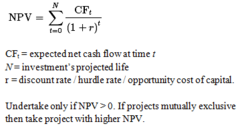
NPV

answer
FV / (1 + i)^n *If NPV is > 0, the project is a good value, invest in it, silly goose. If this is positive, the value of the revenues (cash inflows) is greater than the costs (cash outflows). Projects with a negative net present value should be avoided.
question
EMV
answer
Earned Monetary Value
question
EV
answer
Earned Value
question
EAC
answer
Estimate @ Completion
question
EAC formula
answer
AC + [(BAC - EV)/CPI]
question
EAC formula 2 -NEED TO CLARIFY
answer
AC + BAC - EV
question
BAC
answer
Baseline(??) @ Completion
question
ETC
answer
Estimate to Conpletion
question
ETC formula
answer
EAC - AC
question
SV
answer
Scheduled Variance
question
Variance
answer
Any deviation from the plan
question
Baseline
answer
The approved plan, which is also the formal process of ending the planning phase of the process and beginning of execution and monitoring
question
SV%
answer
If SV% is > than 0, the project is on or ahead of schedule. Props to you, PM.
question
SV% formula
answer
SV/EV
question
CV
answer
Cost Variance
question
CV% formula
answer
CV/EV
question
CV%
answer
If CV% is > 0, the project is on or under budget. Well done, PM.
question
SPI
answer
Schedule Performance Index
question
SPI formula
answer
EV/PV
question
Types of Cost Estimates
answer
1. Expert Judgement 2. Analogous (similar project) 3. Parametric (i.e. $ per sq. ft.) 4. Three-Point Estimate 4.Team Decision-Making 5. Reserve Analysis (Contingency Reserve) 6. Simulation (CB)
question
7 Phases of a Project
answer
1. Wild enthusiasm 2. Disillusionment 3. Chaos 4. Search for the guilty 5. Punishment of the innocent 6. Promotion of the non-participants 7. Define the requirements
question
Progressive Elaboration
answer
When a PM continuously improves and revises a plan as more detailed and specific information becomes available.
question
Rolling Wave Planning
answer
A form of progressive elaboration planning where the work to be accomplished in the near term is planned in detail, while the work far in the future is planned in less detailed form.
question
Agile Methodologies
answer
-Works in environments with dynamic, changing project requirements like software development -Is iterative, team and requirements-driven -Uses repeated cycles of planning -> execution -> reflection. -Sometimes called a SCRUM
question
Product Backlog
answer
-The collection of user stories.
question
Release Backlog
answer
-The collection of selected user stories for this release. -Given a Release Backlog, the team must plan the release. -The team PRIORITIZES the user stories -And ESTIMATES the amount of time/work for each item, and the total amount of time/work for the release backlog
question
PMB
answer
Performance Measurement Baseline, which includes: 1. Scope Baseline 2. Schedule Baseline 3. Cost Baseline
question
Three-Point Estimation
answer
1. Triangular Distribution 2. Beta Distribution
question
Beta Distribution formula
answer
Ce = (Co + 4Cm + Cp)/6
question
Triangular Distribution formula
answer
Ce = (Co + Cm + Cp)/3
question
Ce
answer
Cost estimate
question
Co
answer
Optimistic cost estimate
question
Cm
answer
Most Likely cost estimate
question
Cp
answer
Pessimistic cost estimate
question
CV formula
answer
EV - AC
question
CPI
answer
Cost Performance Index
question
CPI formula
answer
EV/AC
question
Functional Manager
answer
-Are responsible for the deliverable. -Functions of the FM are: 1. How 2. Where 3. Who
question
Project Manager
answer
-Severs at the INTERFACE or INTEGRATION Manager. -Is the high-level integrator -Functions of the PM are: 1. Planning 2. Organizing 3. Directing 4. Controlling
question
Project Sponsor
answer
Senior management who will plan and/or provide: - Act as the negotiator for disagreements between project and functional management - Clarification of critical issues - Communication link with customer's senior management
question
Project Selection Models
answer
1 Numeric and 2 Nonnumeric
question
Project Charter
answer
A document that formally authorizes the existence of a project and provides the project manager with the authority to apply organizational resources to project activities.
question
Project Scope Management
answer
"Scoping" out the work -; What's IN...everything that isn't IN is OUT. Requirements ? Scope ? WBS
question
Requirements
answer
-The Project Scope Management process of determining, documenting, and managing stakeholder needs and requirements to meet project objectives. -What, exactly, do you need/want? -Requirements Documentation ; Requirements Trace-ability Matrix.
question
Scope
answer
-The Project Scope Management process of developing a detailed description of the project and product. -What are the project/service/result boundaries? -Project Scope Statement
question
WBS
answer
-Work Breakdown Structure -The Project Scope Management process of subdividing project deliverables and project work into smaller, more manageable components. -What must be delivered?
question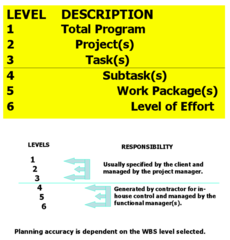
Six-Level Indented Structure

answer
-Most common type of WBS
question
Scope Baseline
answer
-The approved version of the scope statement, work breakdown structure (WBS), and its associated WBS dictionary. -standard to which the performance of the project will be measured.
question
Schedule Compression
answer
2 techniques used used when you want to shorten the duration of your project without changing project scope.
question
Planned Closure
answer
-Transferring responsibility -Completion of project records Historic reports Post project analysis -Documenting results to reflect "as built" product or installation -Acceptance by sponsor/user -Satisfying contractual requirements -Releasing resources Reassignment of project office team members Disposition of functional personnel Disposition of materials -Closing out work orders (financial closeout) -Preparing for financial payments
question
Fast Tracking
answer
Type of Schedule Compression Technique that perform tasks in parallel so you can finish faster. Overlapping tasks in this way often increases risk.
question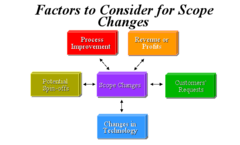
Scope Changes

answer
The further we go into the project's life cycle phases, the more costly the scope changes. Incremental scope changes can be beneficial, but watch out for Scope Creep. Many scope changes were not a business necessity, but were approved by some PMs who valued technical excellence over other outcomes. They wanted to be associated with projects that exceeded standards.
question
Integrated Change Control
answer
1. Review change requests (from any stakeholder) Initiated verbally, but should be recorded in written form and entered into a change management log/system 2. Approve/disapprove change requests Authority to decide often rests with project manager 3. Manage changes to deliverables Approved changes affect cost/schedule/quality and may require re-planning 4. Communicate with stakeholders And don?t forget to update all plans
question
Crashing
answer
Type of Schedule Compression Technique that adds resources to your project so you can finish faster. Crashing almost always involves a financial cost.
question
SOW
answer
Statement of Work -a narrative description of the work to be accomplished in the Project Charter.
question
Project Management Plan
answer
-Defines how the project is executed, monitored & controlled, and closed. -Can be either summary level or detailed, and can be composed of one or more subsidiary plans.
question
Business Case
answer
Used in the development of the Project Charter and provides the necessary information to determine if the project will provide positive NPV.
question
Contract
answer
AKA MOU, LOA, etc., and is part of the Project Charter.
question
Enterprise environmental factors
answer
Included in creation the Project Charter.
question
Organizational Process Assets
answer
Input information used to create the Project Charter.
question
Network Scheduling
answer
Planning & Control Diagramming methods: ADM/CPM/PERT Critical Path Method
question
Necessary "interface management" skills
answer
1. Technical 2. Human 3. Conceptual
question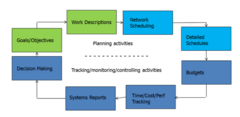
Planning process

answer
-The second PM Process Group. -Includes DEFINING THE SCOPE, WBS, and COST & RISK ESTIMATES. -An iterative process and must be accomplished throughout the life of the project...from "fuzzy" idea to concrete plans.
question
Profit/Profitability Model
answer
Numeric Selection Model: Scoring, Payback Period, IRR, NPV
question
Numeric Model
answer
Profit Profitability, Real Options, and Scoring Quantative
question
Scoring Model
answer
Lists criteria w/scores assigned unweighted yes/no, 1-5 range, weighted 0-10-direct reflection of managerial policy.
question
WAG
answer
Wild Ass Guess
question
What is the highest cost in a project
answer
Labor
question
Non-numeric Model
answer
Sacred Cow (aka scarecrow) Subjective, based on ratings, and rankings
question
PERT AOA (Activity-On-Arrow) convention
answer
For "event-oriented" projects, like R&D, where percent complete cannot be determined...
question
Slack
answer
possible delay when a task can start without impacting the overall completion of the project ES - EF = amount of slack
question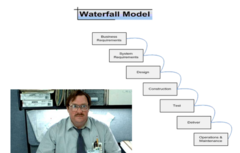
Waterfall Methodologies

answer
("Predictive" life cycles) -Works best in environments with stable, relatively unchanging project requirements (e.g., construction/ manufacturing). -Requires one phase to be completed before moving to the next phase (sequential).
question
Initiating process
answer
-The first PM Process Group. -Includes developing the PROJECT CHARTER and IDENTIFYING STAKEHOLDERS
question
Closing Process
answer
-The fifth PM Process Group. -Includes CLOSING THE PROJECT/PHASE and CLOSING PROCUREMENT.
question
Leads
answer
Acceleration of successor activity
question
Time Estimating Methods (Tools and Techniques)
answer
EAPT (experts, analogous, parametric, triangular/Beta) TCS (team, contingencies, simulation) Think Eat Ticks - EAPT TCS
question
Lags
answer
Delay in the start of a successor activity
question
Measuring Project Progress Curves
answer
1. The "S" Curve 2. The "Stretched-J" Curve PMs rely on project progress to evaluate the plan, decide to/not to invest more resources (if necessary for project completion), or to shut that shit down (aka "kill the project").
question
CPM AON (Activity-On-Node) convention
answer
MS Project uses this
question
Cost Estimating Methods
answer
1. Rough Order of Magnitude (ROM) 2. Approximate 3. Definative/Detailed
question
Monitoring & Control Process
answer
-The fourth PM Process Group. CSP (Cost, Schedule, Performance} -Includes CHANGE CONTROL, VALIDATING/CONTROLLING SCOPE, MONITORING & CONTROLLING RISKS, and CONTROLLING THE SCHEDULE, COSTS, QUALITY, COMMUNICATIONS & PROCUREMENT.
question
Program activities WBS
answer
Program / Project / Task /Sub-tasks (assigned to a person/people) / Work packages (assigned to the job or work that needs to be done)
question
Executing process
answer
-The third PM Process Group. -Includes MANAGING PROJECT WORK, QUALITY ASSURANCE, CONSTRUCTING & MANAGING THE TEAM, MANAGING COMMUNICATIONS, and PROCUREMENT.
question
ITTO
answer
Input -> Tools/Techniques -> Outputs PM uses ITTO for each of the 5 project process. INPUT, TOOLS/TECHNIQUES to achieve OUTPUT.
question
Sequence Activities
answer
The precedence and succession relationships (CPM)
question
Scope Baseline
answer
Goals/Objectives/Activities
question
Schedule Baseline
answer
Sequence/Estimate/Develop project activities and schedules
question
Cost Baseline
answer
Detail/Network (control) Schedule/Budgets/Time/Reporting
question
Purpose of Planning & Control Methods
answer
Basis for planning, decisions, control, evaluate alternatives, provide structure for checking and reporting, what if, identify critical paths, reveal interdependence, aid in risk analysis.
question
IRR
answer
Project Selection Scoring Model. Can have multiple solutions (but easy to use).
question
NPV
answer
= FV/(1+k)n
question
Crashing
answer
Example: A contract called for 140 days, with $200k/day bonus for early completion; same in penalties per day late Extra workers, equipment, pay rates used by contractor - the job was completed in 66 days with $14.8 million bonus
question
Computer-Based Network Tools
answer
MS Project
question
Payback Period
answer
Project Selection Scoring Model. Least precise-(assumes you know what you are going to make),
question
Schedule Compression
answer
Reducing scope/Add more resources i.e. "crashing"/Overlap tasks "fast tracking"/Shorten activities by assigning more resources "outsourcing"/Increase the number of work hours per day (overtime) As you reduce times on the CP, other paths may become critical.
question
CPM - Critical Path
answer
No slack time on CP How much time will it take to plan/execute the project. Any change in the critical path impacts the total finish time. CP activities are the key to "crashing" or schedule compression activities.
question
Fastracking
answer
Overlapping tasks increases risks
question
Organizational structures
answer
FMP = Functional, Matrix, Project Organizations
question
RTFQ&RTFA
answer
Read the (*@$ ing questions, and the *& ing answers)
question
Schedule Control
answer
Use the schedule baseline to ensure it proceeds as planned Update if corrective action and/or changes are needed
question
CPM Forward & Backward Passes
answer
Forward Greater - Proceed from left to right in network, adding activity times to ES times to get EF Backward Smaller - Proceed from right to left in network, subtracting activity times from LF to get LS
question
Challenges project management presents in most corporations
answer
Understand the context of project management. 2. Recognize project team conflict as progress. 3. Understand who the stakeholders are and what they want. 4. Accept and use the political nature of organizations. 5. Lead from the front. 6. Understand what "success"means. 7. Build and maintain a cohesive team. 8. Enthusiasm and despair are both infectious. 9. One look forward is worth two looks back. 10. Remember what you are trying to do. 11. Use time carefully or it will use you. 12. Above all, plan, plan, plan.
question
WIP
answer
Work In Progress -EAC and ETC are WIP formulas



